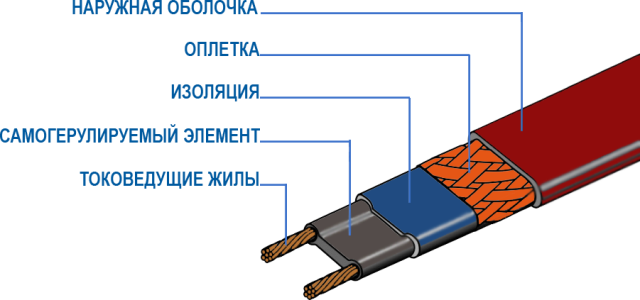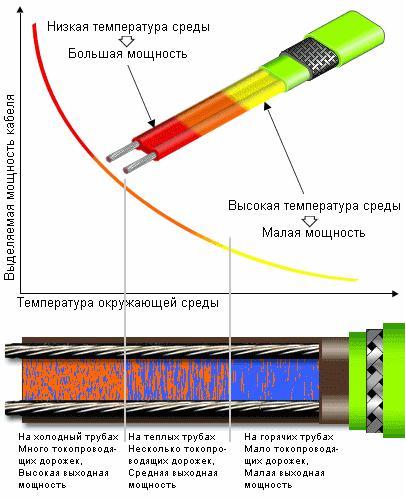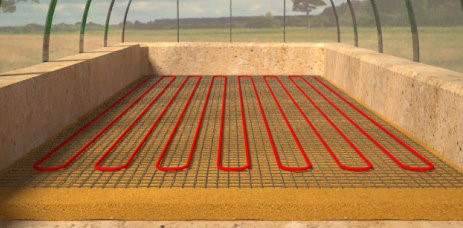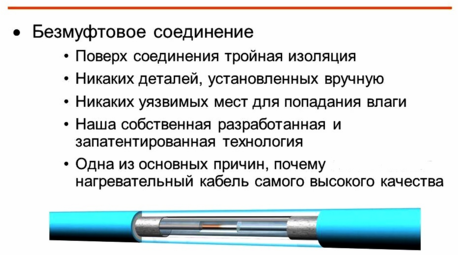Categories: Featured Articles » Sharing experience
Number of views: 10003
Comments on the article: 0
How to make a greenhouse heating with a heating cable
Growing vegetables in a greenhouse requires special attention to all the nuances and conditions. A significant role is played by the temperature of the soil and the environment. Frost is especially dangerous for plants, and if the temperature of the soil drops below the recommended norm, then the seedlings can disappear altogether. Therefore, you need to equip the soil heating system. One of the possible options is heating the greenhouses and soil with a heating cable.

Application features
Heating the soil with a cable will help to achieve a larger crop than without it. Thanks to the heating cable, you will receive the following benefits:
1. The soil will not freeze even in severe frost.
2. Planting seedlings can be done earlier.
3. In warm soil, plants grow faster.
4. The harvest season is extended.
5. Plant growth is possible in the cold season, even in winter, even in cold summer.
6. It is possible to grow thermophilic plants in unusual conditions for them.
7. The process of seed germination is also accelerated.
The optimum temperature is considered to be at the level of 15-25 degrees Celsius. To achieve this temperature, it is necessary to spend 75-100 W / m. In this case, the specified parameters should not be exceeded, since overheating of the root system as well as hypothermia is dangerous.
To save the cable, it should be laid only in those places where plants will grow. Warming the soil under paths and passages is simply meaningless.

Types of heating cables
1. Resistive cable. This cable has high core resistance. When an electric current flows, heat is generated. The advantage is that they are cheap. The disadvantage is that it cannot just be shortened or lengthened because the power output and the total resistance depend on its length. If you lengthen too much, then its resistance will be large, and heating will decrease, if on the contrary, shorten, then the cable will heat up too much, eventually burn out.
Ohm's law works here - the lower the resistance, the greater the current and power. Such cables come in various capacities, the most common with a power of about 30 W / m. In addition, each cable section has the same heat transfer.
2. Zone - this is a type of resistive cables. It differs in that it consists of two conductive wires (copper), between which a spiral is connected. It is called zonal, because the spiral is not solid along its entire length, but is divided into sections - zones. Thanks to this design, it becomes possible to lengthen or shorten it, usually the length of one zone is about 1 m. All zones are connected in parallel.

3. Self-adjusting cable. It is between two conductive cores, between which a heating element is located. As a heating element using a semiconductor material, the so-called a matrix that changes conductivity as a function of temperature. Due to this, it has self-regulating properties. Thus, local overheating is not allowed. Each of the cable sections may have different heat dissipation.
Its design:

Operating principle:

There are also various temperatures.
The first two options are used in conjunction with a thermostat, for the operation of self-regulating cables they can not be used.

Installation of heating cable
In order to lay the heating cable underground, you need to remove the soil layer, from half a meter to a meter. A layer of sand is poured at the bottom of the pit. The thickness of the layer depends on the depth of freezing of the year and minimum temperatures. 20-30 centimeters on average is enough. Sand needs to be tamped, it can be watered for this during tamping. This is necessary so that the heat does not go down. You can fill this layer with concrete or cover with isolon.
Next, the cable is laid on a metal mesh, to which it is attracted by plastic cable ties (clamps) for fixation. There are two styling options - straight lines, or a winding line.

A layer of sand is again laid on top. About 5-10 centimeters and rammed. A protective mesh is applied to protect the heating cable from damage when digging the ground.
The last step is to lay a layer of soil 30-40 cm thick.

Heating cable connection
To connect the heating cable to power, you need to squeeze them with sleeves, and all connections seal with heat shrink tube.
In an article published earlier we have already examined in detail cable extension and connection issues.
A single-core heating cable is connected according to this scheme.

Note:
When buying and laying a cable, its length is selected so that you have enough to go around the entire section and return back to the connection point.
Connection diagram of a two-core heating cable:

It is connected with both cores at one point, and at the end they put on an end sleeve.
You can also find special kits with plug-in connectors for power supply, they are called DEVI EasyConnect.

Or a cable with a clutchless power connection, the end connected to the power source is called cold.


Conclusion
Heating the soil in greenhouses will help you maintain crop and seedlings even with severe frosts. The final result will be better than without them. In addition to the type of heating considered, heating with pipes with hot water is also possible.
An approximate amount of work for organizing soil heating is shown in the video:
See also at bgv.electricianexp.com
:
